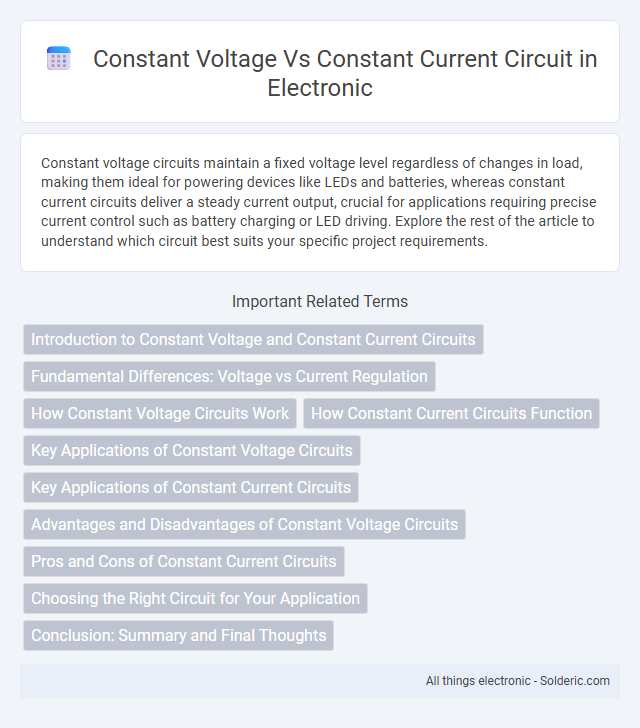Constant voltage circuits maintain a fixed voltage level regardless of changes in load, making them ideal for powering devices like LEDs and batteries, whereas constant current circuits deliver a steady current output, crucial for applications requiring precise current control such as battery charging or LED driving. Explore the rest of the article to understand which circuit best suits your specific project requirements.
Comparison Table
| Aspect | Constant Voltage Circuit | Constant Current Circuit |
|---|---|---|
| Definition | Maintains a fixed voltage output regardless of load variations. | Maintains a fixed current output regardless of load variations. |
| Primary Use | Power supply for devices requiring stable voltage (e.g., electronics, appliances). | LED drivers, battery charging, electroplating--applications needing stable current. |
| Load Behavior | Voltage stays constant; current varies with load resistance. | Current stays constant; voltage varies with load resistance. |
| Protection | Protects device voltage rating; may risk overcurrent if load changes. | Prevents overcurrent; protects sensitive components from current spikes. |
| Complexity | Typically simpler design and cost-effective for common electronics. | More complex design for precise current regulation. |
| Examples | Power adapters, DC power supplies. | LED drivers, current regulators in sensor circuits. |
Introduction to Constant Voltage and Constant Current Circuits
Constant voltage circuits maintain a steady voltage output regardless of changes in load, making them ideal for applications like power supplies and LED drivers. Constant current circuits regulate the current flow, ensuring a fixed current output even when voltage varies, which is essential for devices such as battery chargers and LED lighting systems. Understanding the differences between these circuits helps you select the appropriate design for your electronic application to ensure optimal performance and safety.
Fundamental Differences: Voltage vs Current Regulation
Constant voltage circuits maintain a fixed voltage output regardless of current changes, ensuring stable voltage supply to devices. Constant current circuits regulate the output current to a set level, adjusting voltage as needed to maintain consistent current flow. This fundamental distinction affects their application: constant voltage circuits are ideal for powering electronics with stable voltage requirements, while constant current circuits suit LED lighting and battery charging where current control is critical.
How Constant Voltage Circuits Work
Constant voltage circuits regulate the output voltage to remain fixed despite variations in load current or input voltage, ensuring stable performance for sensitive electronic components. These circuits typically use feedback control mechanisms, such as voltage regulators or operational amplifiers, to continuously monitor and adjust the voltage level. Your devices benefit from consistent power delivery, reducing the risk of damage caused by voltage fluctuations.
How Constant Current Circuits Function
Constant current circuits regulate the flow of electric current to maintain a steady level regardless of voltage changes or load variations. They achieve this by continuously adjusting the voltage output to compensate for resistance fluctuations, ensuring consistent current delivery to devices like LEDs or battery chargers. Your electronic systems benefit from enhanced stability and protection when powered by a precisely controlled constant current source.
Key Applications of Constant Voltage Circuits
Constant voltage circuits are essential in powering devices such as LED lighting systems, where maintaining a steady voltage ensures consistent brightness and prevents damage. These circuits are widely used in battery charging applications to provide a stable voltage output that protects battery health. Industrial automation and control systems also rely on constant voltage circuits for reliable operation of sensors and microcontrollers.
Key Applications of Constant Current Circuits
Constant current circuits are essential in applications such as LED lighting, where maintaining a steady current prevents damage and ensures consistent brightness. They are widely used in battery charging systems to deliver a precise charging current, enhancing battery lifespan and safety. Another key application is in sensor excitation, where stable current supplies improve measurement accuracy and reliability.
Advantages and Disadvantages of Constant Voltage Circuits
Constant voltage circuits offer the advantage of maintaining a stable voltage level, ideal for powering devices requiring consistent voltage such as LED lighting and battery charging systems. These circuits simplify design and protect sensitive electronics from voltage fluctuations but can be less efficient when the load varies significantly, leading to energy loss and heat generation. Your choice depends on the application's need for voltage stability versus efficiency and load adaptability.
Pros and Cons of Constant Current Circuits
Constant current circuits offer the advantage of maintaining a steady current flow regardless of voltage fluctuations, making them ideal for LED lighting and battery charging applications where precise current control is crucial. However, they can be less efficient and generate more heat due to voltage variations, potentially requiring more robust components and cooling solutions. Your choice depends on whether consistent current or voltage regulation is more critical for your specific electronic design or device operation.
Choosing the Right Circuit for Your Application
Selecting between constant voltage and constant current circuits depends on the specific needs of your application, such as LED lighting or battery charging. Constant voltage circuits provide a stable voltage output ideal for devices requiring fixed voltage levels, while constant current circuits ensure a consistent current flow, crucial for applications like LED arrays to prevent damage and maintain brightness. Understanding your load characteristics and power source limitations is essential for efficient and safe circuit operation.
Conclusion: Summary and Final Thoughts
Constant voltage circuits maintain a steady voltage level regardless of load variations, making them ideal for applications like LED drivers and battery chargers. Constant current circuits regulate the current flow to ensure consistent current output, crucial for devices requiring precise current control such as laser diodes and power supplies. Selecting between constant voltage and constant current circuits depends on the specific requirements of voltage stability versus current regulation in electronic system design.
constant voltage vs constant current circuit Infographic

 solderic.com
solderic.com